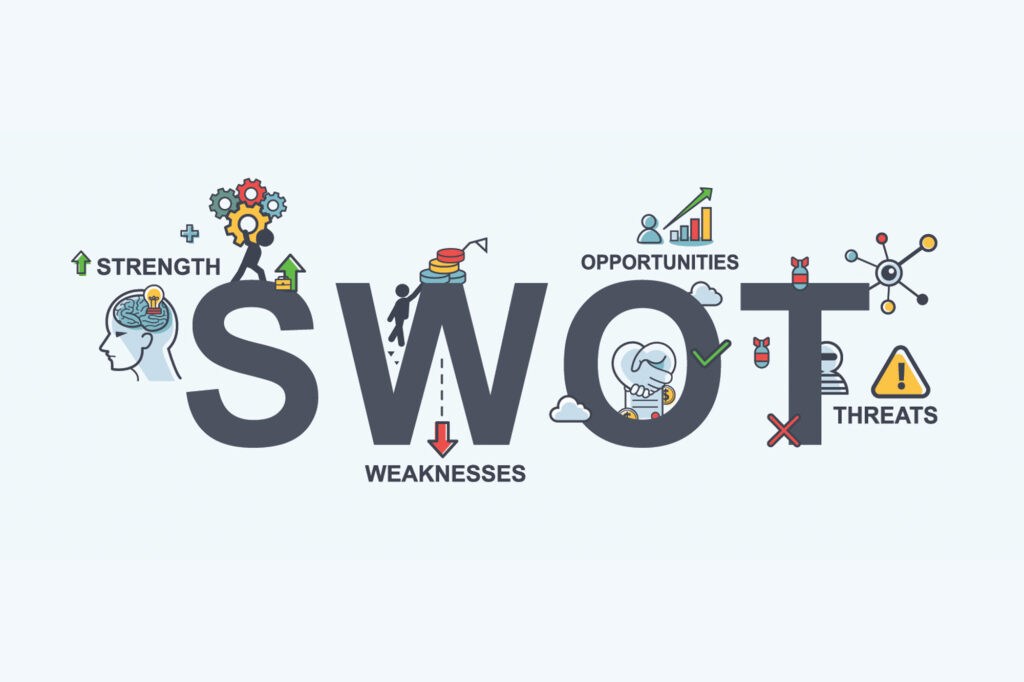8 Ways How To Build A Marketing Strategy For Your New Business

For a company to succeed in today’s competitive market, it must have a solid marketing strategy. Your early-stage business objectives may change as you refine your concept of success. However, there are typically just two broad types of objectives for new businesses: expanding brand recognition or expanding client base. While it’s true that both sets of objectives are vital to your startup’s growth, it is recommended to give more weight to the ones that make the most sense to you personally.
The marketing plan is the strategic document that answers the question, “What specific actions will you take to achieve your objectives and put your strategy into action?” from the perspective of the company’s overarching vision.
We’ve compiled a list of some helpful action points to pay attention to when performing your research to help you create an outstanding action plan.
1. Carry Out A S.W.O.T.

You should first do a SWOT analysis to determine the relative merits of your company’s current assets, liabilities, prospects, and potential dangers.
It’s an enjoyable team activity that will inform the rest of the steps in your planning in some significant way. Gather as many of your coworkers as possible to help out, both to reduce the likelihood of bias and to increase the breadth of your coverage.
Improve exposure for the brand. A great way to kick off a new venture is by making a good first impression with your target audience. You need to introduce yourself, describe your expertise, and highlight your unique selling points. If building brand recognition is your top marketing priority, then that is what your efforts and approach will be focused on. Also, if you are exploring new sectors, make sure that your content is translated to the language used in those sectors. Otherwise, it will become extremely difficult for you to connect with your prospective buyers. Make sure to hire the translation services of reputed companies like Future Trans.
2. Find Ways To Attract New Buyers
If expanding your customer base is a top objective, you could aim to increase the number of individuals who sign up for your service, get more people to use your product, or close more leads into buyers. To achieve these objectives, you will need to create a marketing plan that employs eye-catching design, persuasive writing, and compelling calls to action to interest potential customers in your products and services.
3. Identify Who You’re Trying To Reach

Any kind of company needs to make sure it’s reaching the appropriate people with the right message. Think about your target market or audience when you craft your marketing plan.
You can narrow down your potential customers by asking yourself the following questions:
- Can you describe the value you’re providing to prospective buyers?
- Why should people choose you?
- When faced with a choice between you and a competition, why should a potential client pick you?
- To what extent do larger companies or companies operating in a certain field stand to benefit from your business-to-business offering?
4. Identify Your Market Niche
Take the time to investigate competitive offerings and measure consumer interest to give your firm a fighting chance against these problems. If you’ve already found a market for your product or service, then you can begin planning how you’ll get the word out to potential customers about what you have to offer.
5. Set A Spending Limit

When creating a marketing plan for a new business, it is important to take into account operational expenses and revenue projections. Spending intelligently in marketing is essential, regardless of the size of your budget. Spend your marketing budget wisely by putting your attention and resources where they will do the most good. If one approach isn’t producing results, don’t be afraid to switch gears and try another.
You’ll be in a better position to craft a well-informed marketing strategy if you have a firm grasp on your strengths, areas for improvement, and the external factors that serve as the impetus for your business’s existence or, alternatively, those that pose a threat to its survival.
6. Determine The Selling Point
Instead of starting from scratch, a strong marketing strategy should be derived from the company’s value proposition, which sums together the company’s advantages (as determined by the SWOT analysis) and competitive advantages.
One of the most crucial conversion aspects and what might make the difference between closing a sale and losing it is determining your value offer. Therefore this is definitely the phase you should devote the most time and money into.
Start by establishing the primary differentiators, and then describe the main consumer benefits and the value your products and services provide to the customer.
The most compelling value propositions are direct and centered on resolving issues for the target audience.
7. Create A List Of Ideal Customers

You can use buyer personas to create fictional, broad representations of your ideal clients. They facilitate a more intimate relationship between brands and their customers as individuals.
A variety of sources, including website statistics, social media channels, customer reviews, and in-person meetings with prospects and customers, all contribute to the development of buyer personas.
Investigate and construct personas by learning as much as possible about your target audience, including their likes, dislikes, demographics, and preferred communication routes.
8. Examine The Marketplace And The Rival Companies
You need to have an in-depth understanding of your industry and your competitors’ situations, including the challenges they are facing. In what ways are they succeeding? Where do their cracks show up?
You can learn a lot about market opportunities as well as emerging trends and ground-breaking ideas if you keep your eyes and ears open.
Final Word
It’s crucial to decide early on which aspects of marketing you’ll prioritize and how much resources you’ll dedicate to each, such as advertising, public relations, content marketing, search engine optimization, community management, events, and so on, based on the type of business you run and the demographics of your target audience.




